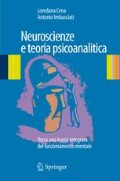Riassunto
La memoria non è solo una funzione biologicamente fondamentale, ma contribuisce in modo importante nel formare l’identità dell’individuo. Siamo ciò che siamo perché abbiamo le nostre memorie. Le nostre percezioni, risposte agli stimoli ed emozioni sono tutte intimamente legate alle nostre memorie. Le memorie ci permettono di utilizzare ciò che abbiamo imparato in esperienze precedenti per rispondere a situazioni presenti nel modo più adatto e vantaggioso. A volte, però, i nostri comportamenti non sono adatti o vantaggiosi ma, al contrario, ci portano a rispondere in modo disfunzionale con conseguente sviluppo di psicopatologie come, ad esempio, stati di ansia, depressione, compulsione e ossessione. I meccanismi che stanno alla base di queste condizioni non sono totalmente conosciuti e, indubbiamente, l’impatto che queste patologie hanno sulla salute della nostra società è largamente sottostimato.
Access this chapter
Tax calculation will be finalised at checkout
Purchases are for personal use only
Preview
Unable to display preview. Download preview PDF.
Bibliografia
Alberini CM (2009) Transcription factors in long-term memory and synaptic plasticity. Physiol Rev 89:121–145
Alberini CM (2011) The role of reconsolidation and the dynamic process of long-term memory formation and storage. Front Behav Neurosci 5:12
Freud S (1887–1904) Lettere a Wilhelm Fliess. Bollati Boringhieri, Torino
Inda MC, Muravieva EV, Alberini CM (2011) Memory retrieval and the passage of time: from reconsolidation and strengthening to extinction. J Neurosci 31:1635–1643
Milekic MH, Alberini CM (2002) Temporally graded requirement for protein synthesis following memory reactivation. Neuron 36:521–525
Nader K, Schafe GE, LeDoux JE (2000) Fear memories require protein synthesis in the amygdala for reconsolidation after retrieval. Nature 406:722–726
Squire LR, Zola SM (1996) Structure and function of declarative and nondeclarative memory systems. Proc Natl Acad Sci U S A 93:13515–13522
Taubenfeld SM, Riceberg JS, New AS, Alberini CM (2009) Preclinical assessment for selectively disrupting a traumatic memory via postretrieval inhibition of glucocorticoid receptors. Biol Psychiatry 65:249–257
Tronel S, Milekic MH, Alberini CM (2005) Linking new information to a reactivated memory requires consolidation and not reconsolidation mechanisms. PLoS Biol 3(9):e293
Author information
Authors and Affiliations
Corresponding author
Rights and permissions
Copyright information
© 2014 Springer-Verlag Italia
About this chapter
Cite this chapter
Alberini, C.M. (2014). Memoria: traccia fragile e dinamica. In: Neuroscienze e teoria psicoanalitica. Springer, Milano. https://doi.org/10.1007/978-88-470-5346-5_1
Download citation
DOI: https://doi.org/10.1007/978-88-470-5346-5_1
Publisher Name: Springer, Milano
Print ISBN: 978-88-470-5345-8
Online ISBN: 978-88-470-5346-5
eBook Packages: Behavioral ScienceBehavioral Science and Psychology (R0)

